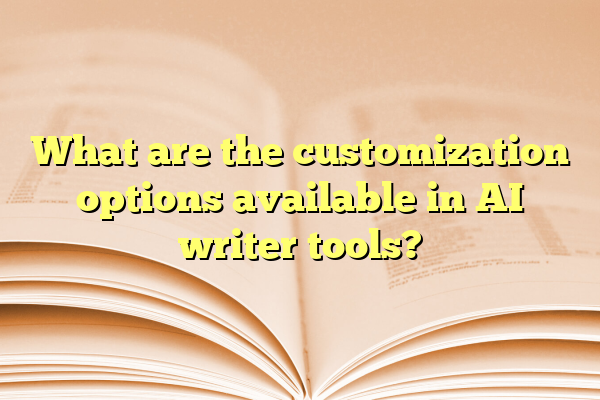
What are the customization options available in AI writer tools?
In recent years, AI writer tools have become indispensable for businesses, marketers, bloggers, and students alike. These tools utilize advanced machine learning algorithms to generate high-quality content in a fraction of the time it would take a human writer. One of the most compelling aspects of using AI-powered writing solutions is the wide array of customization options they offer. These options enable users to finely tune the output so that it meets specific needs, whether for professional, academic, or creative purposes.
Below, we explore the various customization features available in AI writing tools, providing insights into how each can be used to tailor content more effectively.
Contents
1. Tone and Style Adjustment
One of the foundational customization options in AI writer tools is the ability to alter the tone and style of the content. Whether the user requires a formal tone for a corporate white paper or a conversational tone for a blog post, AI platforms are often equipped with predefined tone settings such as:
- Professional
- Friendly
- Assertive
- Informative
- Witty or humorous
This level of control helps ensure that the content resonates with its intended audience while maintaining brand consistency.

2. Content Length Control
Another critical feature is the ability to customize the length of the generated text. Some applications require concise summaries, while others demand long-form pieces. Most AI writing tools provide options to select from:
- Short (50–100 words)
- Medium (300–600 words)
- Long (700+ words)
This allows users to adapt their message depending on the platform — for example, a tweet versus an in-depth report.
3. Keyword Integration
Keyword suggestion and placement are often built-in, especially in AI tools used for SEO and digital marketing. Users can input target keywords manually, and the AI will integrate them into the content at optimal positions for search engine visibility. Advanced tools also recommend additional keywords based on current search trends and competition levels.
For content strategists and marketers, this feature is indispensable in enhancing reach and engagement.
4. Language and Regional Customization
Many writing tools now support a range of languages and regional dialects. For instance, users can specify whether they want the content in:
- British or American English
- Formal or informal tone in French, Spanish, or German
- Localized vocabulary for specific markets (e.g., UK vs. US financial terms)
This helps create content that feels authentic and localized, crucial for international brands and multilingual websites.

5. Industry-Specific Templates
Modern AI writer tools often come equipped with predefined templates tailored to various industries. For example:
- E-commerce product descriptions
- Legal document drafts
- Healthcare content with medical terminology
- Technical documentation
These templates ensure that the content adheres to the industry’s tone, terminology, and structural requirements, reducing the amount of editing required post-generation.
6. Custom Input Prompts
Advanced users can influence what the AI generates by crafting detailed input prompts. These prompts guide the AI with specific context or desired information, allowing for highly targeted content. Some tools even support variables and tags within the prompt to maintain consistency throughout longer documents.
This flexibility provides a semi-automated writing experience that blends human creativity with AI efficiency.
7. Voice Consistency and Brand Guidelines
More sophisticated AI platforms allow organizations to upload brand guidelines, ensuring that all generated content stays compliant with pre-established voice, wording, and formatting standards. This is especially important for larger companies seeking to preserve a consistent brand identity across different content types.
Conclusion
AI writer tools have come a long way from generating generic paragraphs to producing highly customized, audience-specific, and search-optimized content. Features such as tone control, length adjustment, keyword integration, and language localization equip users with everything they need to create effective and purposeful content.
For anyone looking to streamline their content generation process without compromising on quality or relevance, understanding and utilizing these customization options is essential. As the technology continues to evolve, more sophisticated and intuitive customization features will undoubtedly emerge, raising the standard for what AI-assisted writing can achieve.
